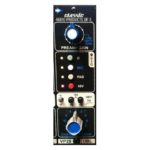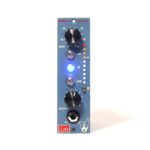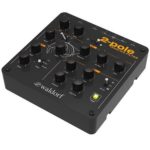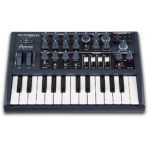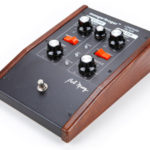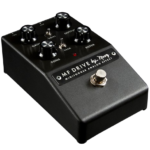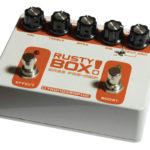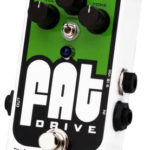The Best Outboard Saturation Options? 8 Great Analog Saturators on a Budget
Great saturation: Everyone knows it when they hear it, whether they recognize it or not. It’s on our favorite albums from the 60’s and 70’s right up to recent offerings from Beck and Alabama Shakes. It shapes the perfect guitar tone and leaves its print on every amazing vocal you’ve ever heard.
Back in the day it was simply the byproduct of a day’s work: Audio passed multiple times through tubes and transformers on its way to its eventual recording to tape. Each additional process, or “bounce”, landed back on tape yet again. Yesteryear’s audio engineers spent a considerable amount of time trying to minimize distortion and saturation, but it was inevitably part of the signal chain.
Fast forward to today, and digital audio has brought us some of the cleanest signal paths ever known to mankind. Oh, how jealous the engineer of 1970 would be! No more wow and flutter, no more hiss, just pure pristine audio.
Yet all that cleanliness caused other problems that audiophiles weren’t ready for: Digital audio was missing those softened harmonic overtones that our ears had become accustomed to. At the same time, a downsized music industry had made large mixing consoles and tape decks more scarce. All of this led to audio lacking the traditional analog saturation that fast became a buzzword known as “warmth”.
A sneak peek of the 8 affordable saturators found below.
Thankfully, many of the same companies responsible for analog warmth came to the rescue by providing smaller, less costly gear. Single and dual channel strips and saturation units from manufacturers such as Neve, API, SSL, Chandler, Manley and Thermionic Culture dedicate themselves to creating the type of class A saturation that our vintage ears crave. Sure, they may cost thousands of dollars, but this is still considerably less than your typical 1970s studio expenditures.
But what if you don’t have a budget of thousands yet you still want to saturate like it’s 1975? You’re in good company because today, we are going to look a few hardware boxes that can give you the studio grade saturation you crave without breaking the bank.
Below, you’ll find a collection of easy-to-find stomp boxes, DIY mic preamps, and a few filters that can get the job done for under $300 (plus a little soldering for the mic pre kits).
We’ll take a closer look at each one and listen to some audio examples so your ears can be the judge. I’ve run a dry bass and acoustic drumset through each one using fairly extreme settings to get a flavor of what each box is capable of. Each audio example starts with a mild setting and ends extreme. (Or sweeps through settings in the case of filters, which I’ve labeled “sweep” below). Mind you, there are many more possible settings to try, especially on the filters, so experimentation is key.
Okay— onto the audio:
First let’s hear the dry tracks. The drums are from Toontrack’s EZ Drummer while the bass playing is by Patrick LeFrancois from Goldishack Guerrilla’s “This Song Is Your Song”. [For high-res versions of all of the audio files in this roundup, click here.]:
1. Capi VP28 Mic Preamp
Hailed as a DIY “holy grail” mic preamp, this 500-series preamp also accepts line level signal and has a killer lo-cut filter to boot.
For this application, we are using it at line level with the gain turned up on the input while lowering the output to compensate.
2. Hairball Lola Mic Preamp
This is another great 500 series preamp that has a line level switch and a DI input on the front.
For these clips, we used similar settings as the Capi, driving the line input while lowering the output:
3. Waldorf 2-Pole Filter
This is a standalone filter with 2 types of distortion, plus an envelope and LFO. The 2-Pole is a versatile device with a nice overdrive, plus a “rectifier” circuit which scoops the low end a bit and adds upper octave harmonics.
I’ve included a couple of extra audio clips to show off the filter. Special mention that this unit also self-oscillates (though we won’t be using that feature today.)
4. Arturia Microbrute
Okay, so this one is a synth, but it’s also an extremely versatile saturation device with too many features to mention.
For these samples, we’re using the audio input function. The bass clip has a tempo-synced LFO modulating the filter cutoff, just for fun.
5. Moog Moogerfooger MF101
This is basically a lowpass filter pedal. Perhaps the classic big filter pedal, with an envelope. You can hear the filter envelope kick in on extreme settings in the drum clip below.
6. Moog Minifooger MF Drive
This pedal is the smaller and cheaper version of the big Moogerfooger above, but it still packs a growl.
7. Tronographic “Rusty Box”
This deep, rich pedal is made for bass guitar and has a really useful EQ for dialing in sweet spots. For this sample, I cut most of the highs and it seemed to do the trick. This also has a line out jack which is handy for hooking up to a mixer. I did a sweep on the drums to illustrate the various sweet spots.
8. Pigtronix FAT pedal
This is a great guitar pedal, and I’ve included it to illustrate what a nice overdrive can do to your audio signals. There is only one setting on these examples.
Summing it Up
So there you have it: All of these affordable hardware units can be driven hard to varying results. It’s all subjective, but I think they all sound great in their own way. You decide for yourself how much grit you want and how much fidelity to retain.
It’s always surprising to me how even extreme settings can sound extremely natural in a mix. These can also be mixed in parallel with the dry audio for more fidelity. And, if you happen to have more than a pair of inputs and outputs available on your interface, these can easily be hooked up to your DAW as an external effect without compromise.
I hope this roundup helpful to you. Maybe you have something already around your place that will work. Got a pedal laying around? Or really, any analog piece with inputs to overdrive? Let your ears be the judge and explore!
If you have any recommendations of your own, please tell us about them in the comments below.
Please note: When you buy products through links on this page, we may earn an affiliate commission.







